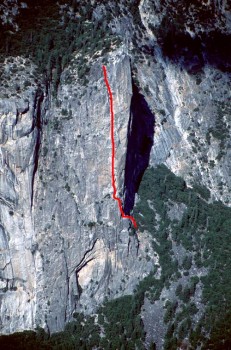South Face of Washington Column
Layton Kor
AAJ 1965, p329
AS SMOOTH and beautiful as the great rock faces which surround it, Yosemite’s Washington Column rises sheer from the valley floor to its tree-covered rim, 1500 feet above. After several attempts, in July of 1959 two superb climbers, Warren Harding and Chuck Pratt, succeeded in surmounting the great east face. Their ascent required days of difficult vertical climbing. However, the south face, a great barrier of polished slabs with its obscure connecting crack system, remained untouched with the exception of Dinner Ledge, a popular climb up the lower 450 feet.
Chris Fredricks and I arose at 4:30 A.M. on a warm and clear mid-September morning. We were slow getting under way not only because of our inner feelings about potential route problems but also because an animal had eaten most of our bivouac food during the night. After two hours of toe-stubbing and wandering in the dark, we finally crossed the top of a huge scree slide and stood at the base of the wall. We changed gear from packs to the hauling bag and began the climb. Well trained in Yosemite methods, Chris moved quickly and soon disappeared from sight. A few minutes later, the hauling bag with its repetitious scraping followed and at last I too was on my way, Two rope-lengths of 5th and 6th class climbing carried us to a large tree 350 feet up the wall. From here a diagonal traverse of 80 feet put us on Dinner Ledge at half past ten in the morning, Since the main problems were just beginning, I draped myself with 30 pitons and started up the high-angle slab directly above the ledge. On shaky knife-blades, I led to a blank spot and surmounted it with two bolts.
After a long reach to a hidden diagonal crack, which we nailed for 45 feet, we got to a belay in slings. The next lead turned out to be the most complicated but finest of the climb. Roofs interspersed with blank spots which required bolts ended at an overhanging arch, where we pitoned for 35 feet to the left, From this point a 25.foot pendulum swung us lelft to a different crack system where our final bolt secured another sling belay, Little by little, the wall’s defenses opened up to US and our indecision turned to sheer joy, The day’s approaching end confronted us with the choice of rappelling to Dinner Ledge or pushing for a bivouac spot higher up, possibly in a small broken area 140 feet above us. We decided on the latter. Another overhanging arch and a vertical crack above it led us to a tiny dent in the rock. While Chris belayed, I used the last rays of the sun to complete still another 70 feet of nailing. When darkness put an end to our progress, I anchored the rope and rappelled down to Chris. Together we two spent the night in a place where there was hardly room enough for one person.
The night passed slowly, but we made up for our discomfort by having our fill of food and water. After hours of changing from one cramped position to another, we finally greeted the morning by prusiking up the rope left the night before. Route finding was no longer a problem, since the single crack system showed the way. Higher, the cracks widened and we climbed free for a full rope-length, an enjoyable lead which ended in a narrow gully 500 feet below the summit. The next pitch followed a bushy groove filled with loose blocks. After setting up a belay in a tight chimney, I pulled up the hauling bag, which spewed loose rocks down the wall. Luckily Chris was safely hidden under an overhang, which hardly stemmed the flow of choice words he had for me. The frightening five-inch crack above turned out to be the crux of the climb. We handled this grim section with the well-known technique of struggling. After a short rest and some much needed water, we pushed on. Above a 50-foot vertical crack, we diagonaled left past large flakes to a ledge shaded by a big tree. The last lead of the climb went up the rotten chimney over our heads. At noon on the second day, we unroped. A five-minute hike took us to the summit register of Washington Column after one of the most enjoyable and challenging climbs of the season.
Summary of Statistics.
AREA: Yosemite Valley, California.
ASCENT: First ascent of South Face of Washington Column by Christopher
Fredricks and Layton Kor, September 20 and 21, 1964.
TECHNICAL DATA: NCCS V, F9, A3. 5 expansion bolts, 175 pitons





